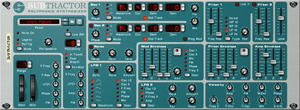
The Propellerhead SubTractor synthesiser

The Propellerhead SubTractor synthesiser
A synthetic timbre sounds more pleasant if the shape of the waveform subtly changes over time as its various harmonics fade in and out. To put it another way, a periodic waveform does not sound as interesting as a quasi-periodic waveform.
The most popular way to generate a quasi-periodic waveform with analogue electronics is to use pulsewidth modulation, or PWM for short, which generates a pulse waveform that has a varying duty cycle. While this technique works well in analogue electronics, there is another type of modulation that is ideally suited to virtual synthesisers which use lookup tables in place of tangible oscillators.
Waveforms can be looked at in several ways, such as shapes or harmonics. Once a waveform has been digitised, however, it can be seen in yet another way: as a series of numbers. This is where virtual synthesisers come into their element: because they run on computers, they are great at performing simple calculations on numbers. It is trivially easy for a computer program to take two waveforms and multiply them together or subtract one from the other.
How phase offset modulation works is to take a lookup table, and generate two instances of its waveform at the same frequency. One of them should be further ahead or behind in its cycle, making the two waveforms slightly out of sync with each other. Either the values of the waveforms are multiplied together, or the value of one of them is subtracted from the other one.
This process generates an entirely new waveform with a drastically different shape. For example, one ramp wave subtracted from another will create a pulse wave, with the amount of offset (the difference between the two waveforms' starting points) dictating its duty cycle. If you slowly change the offset amount, you get pulsewidth modulation.
Using this technique, not only can you achieve pulsewidth modulation using a ramp wave, you can also create a comparable effect using any other periodic waveform, creating an entirely new quasi-periodic waveform.
So far, the only instrument I know of which uses phase offset modulation is SubTractor, part of the Reason virtual studio by Propellerhead Software. It seems like a rather elegant solution to the problem of digitally creating quasi-periodic waveforms using very little processing power. Hopefully more synthesisers will employ this technique in the future, as analogue hardware is increasingly being replaced by more convenient software alternatives.